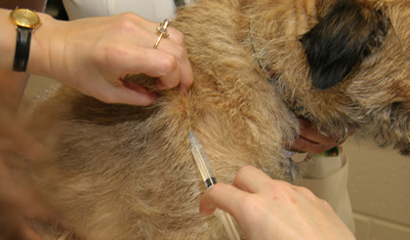
Rabies: what you need to know
Most pet owners aren’t concerned about their animals contracting rabies, but the reality is that infection with the deadly virus usually results in death for animals as well as people.
Transmission
Rabies is transmitted through salivary secretions of infected animals. Bites are the most common source of transmission, but infection can also occur through salivary contact with mucous membranes such as the mouth and eyes.
The rabies virus is introduced into the body through the bite wound, and then it travels by peripheral nerves to the central nervous system (CNS). The closer the bite is to the CNS, the faster the disease will progress.
Incubation period
The incubation period can last anywhere from three weeks to six months.
Treatment
If given early post-exposure treatment, some animals will mount an effective enough immune response to fight the infection. But once the virus reaches the central nervous system nothing can be done.
If a veterinarian suspects rabies, the affected animal is humanely euthanized before the virus progresses any further. The rabies virus causes muscle paralysis, and eventually, an infected animal will not be able to move its lungs to breathe. Rabies can’t be definitively diagnosed until a post mortem examination of brain tissue is performed.
Prevention
The best prevention is to vaccinate all cats, dogs and ferrets against rabies, regardless of whether they’re indoor or outdoor pets. People such as veterinarians and other health care practitioners who are at risk for coming in contact with potentially rabid animals should also be vaccinated.
Dogs and cats as young as three months old can be given the rabies vaccine, and a booster shot is required one year later. Depending on the specific vaccine used, additional booster shots are required every one to three years.
If you suspect rabies infection
Rabies is a zoonotic disease — a disease that can be passed from animals to other animals and humans. And since infection almost always results in death, the health risk for humans is enormous.
If a rabid animal bites an unvaccinated pet, the unvaccinated animal could be placed in quarantine for up to six months as a safety precaution. In Saskatchewan, the recommendation to quarantine an affected animal is made by a veterinary inspector. Authorized personnel in similar roles make the decision to quarantine in other Canadian provinces. But even if your pet is vaccinated, call your veterinarian if it’s bitten by a wild animal. Your veterinarian may still recommend quarantining your pet, and it should undergo a recommended post-exposure protocol.
If you suspect your pet or another animal to have rabies, proceed with extreme caution. Wear gloves and put the animal into a crate where they can’t bite anyone. Uncharacteristic behaviours may be seen in rabid animals so even previously gentle pets may bite if they become infected.
The safest mode of action is to contact your local animal control office if you suspect an animals to be rabid or call the Saskatchewan rabies information line at 1-844-7-RABIES (1-844-772-2437). If a person has been bit or has been in contact with an animal that may be rabid, please contact your local public health authorities.
For more information about rabies and its prevention, visit the rabies information page on the U.S. Centers for Disease Control and Prevention (CDC) web site.

